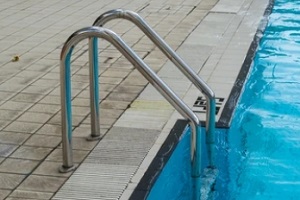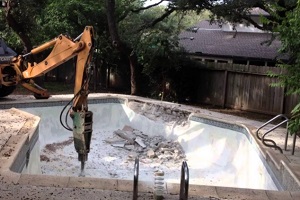 If you have an aging pool on your property, you may be wondering about the best way to address it. For many homeowners, the choice comes down to two main options: remodeling the old inground pool or removing it from the yard and using the area for a different purpose.
If you have an aging pool on your property, you may be wondering about the best way to address it. For many homeowners, the choice comes down to two main options: remodeling the old inground pool or removing it from the yard and using the area for a different purpose.
In some cases, the right solution may be obvious. For example, if no one in your home enjoys swimming or you have major concerns about the safety risks, such as if your family has small children, removing it is the best option. However, if you do not mind the maintenance expenses and use your pool occasionally, remodeling it may be an option worth considering, depending on the pool’s condition. Here is a closer look at what these options entail and what you should keep in mind when making your decision.
When Does Remodeling a Pool Make Sense?
If you are fairly certain that you want to continue using your swimming pool, remodeling it may be the best option. However, it is important to make sure it fits into your budget and that you understand what is involved in the process. The cost of remodeling a concrete pool will depend on the amount of work the pool needs and the size of the project, but it can range anywhere from thousands to tens of thousands of dollars.
On top of that, you will need to factor in the ongoing maintenance expenses involved in owning and maintaining a pool. According to HomeGuide, pool maintenance costs an average of $122 per month, or $1,400 per year, while a one-time cleaning can cost $250 and up. Pools that are only used seasonally will also have costs associated with opening and closing them, which typically costs around $300. Once you factor in electricity, water, repairs and maintenance, the annual cost of owning a pool is in the range of $3,000 to $5,000. (1)
What Does Pool Remodeling Entail?
For some homeowners, remodeling the pool is as simple as refinishing the plaster or adding some new tile at the water line. For others, however, extensive and complicated repairs may be desired. For example, if you want to add some built-in features to your pool, install accessories or change its shape, you can expect the project to be significantly more expensive.
Some of the steps you might take to remodel your pool when it comes to functional aspects include resurfacing plaster, changing the surface from plaster to aggregate or tile, adding new lights and heaters, installing an automatic pool cover, switching your pool to a saltwater system, and updating old plumbing.
When it comes to giving it an aesthetic remodel, you might choose to change its size, shape or design, add water features or a beach-style entry, install a slide or jacuzzi, or give the pool deck a refresh.
When Does Pool Removal Make Sense?
 For many homeowners, it makes more sense to have the pool removed entirely. For people who only swim occasionally, the high costs involved in maintaining a swimming pool may be prohibitive. In many cases, removing a pool is a more cost-effective option than remodeling it. Like remodeling, the cost of removing a pool depends largely on the size and complexity of the project, which includes factors such as the material of the pool and how easy it is to access.
For many homeowners, it makes more sense to have the pool removed entirely. For people who only swim occasionally, the high costs involved in maintaining a swimming pool may be prohibitive. In many cases, removing a pool is a more cost-effective option than remodeling it. Like remodeling, the cost of removing a pool depends largely on the size and complexity of the project, which includes factors such as the material of the pool and how easy it is to access.
The Pool Removal Process
There are two main methods for having a pool removed. One is a pool fill-in, which is a more affordable but less comprehensive approach, and the other is a full pool removal. Here is a closer look at the main steps involved in these processes and the advantages and drawbacks of each approach.
Pool Fill-In
As the name suggests, a pool fill-in, also known as a partial removal, entails filling the pool in and covering it up. However, it is not as simple as laying some dirt inside the shell. First, the pool needs to be drained so that holes can be punched into the bottom of it. Then, the top layer of the pool is demolished up to three feet deep, and the rubble that results from the demolition is placed into the bottom of the pool. It is then filled with additional dirt and topsoil. Then, the soil must be compacted to avoid problems in the yard in the future.
A pool fill-in is the quickest and most affordable option when it comes to pool removal. It may only take a couple of days. However, if you use this approach, you will need to disclose it to future buyers of your property and keep in mind that it could impact your home’s resale value. Many municipalities will consider the area where the pool was to be non-buildable. This means that you cannot build additions or dwellings there in the future, although landscaping, trees and sheds will be permitted.
Another thing to keep in mind is that when this method is not carried out correctly, there is a greater risk of swelling, sinkage, or poor draining in the yard.
Full Pool Removal
Having a full pool removal is the most complete method and leaves the yard as though a pool never existed there. After draining the pool, all of its materials are removed and hauled away. Then, the area will be filled with soil or gravel and compacted to create a stable surface.
 Getting a full pool removal should not have any impact on the value of the home when it is time to sell. Moreover, the absence of concrete buried in the old pool that would occur with a fill-in means that there is almost no risk of seepage or sinkage.
Getting a full pool removal should not have any impact on the value of the home when it is time to sell. Moreover, the absence of concrete buried in the old pool that would occur with a fill-in means that there is almost no risk of seepage or sinkage.
Another big benefit of this route, despite being more expensive, is that most municipalities will consider the area where the pool stood to be buildable.
Reach Out to Dirt Connections
If you are interested in learning more about pool removal or remodeling in Northern Virginia, reach out to the experienced professionals at Dirt Connections to discuss your project.
Summary

Dirt Connections was started with one goal in mind: providing quality residential and commercial construction services to clients on time and on budget. Reach out for more information on how we can support your next project.
For your convenience our estimates are free and by appointment. Call 703-940-9949 for a free estimate today!









































